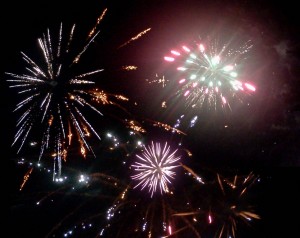
Using The Gimp, I was able to take several individual fireworks snapshots and composite them thus creating this single, dynamic photo.
I love fireworks! I absolutely love seeing a fireworks display during Independence Day celebrations! And I saw some awesome displays this past Fourth of July.
During the fireworks displays, I snapped some photos.
Since my camera phone really isn’t the best or most sophisticated, it was a bit of a challenge capturing some of the star-bursts. However, after I got home with the half dozen or so snapshots, I was able to composite some of the better pics in Gimp.
If you don’t already know, Gimp is the free, open source alternative to high-priced commercial graphics editing applications like Photoshop.
Although, you can download and install Gimp for Windows and Mac, it comes free with Linux. and, in my opinion, it works best on the Linux platform.
The photo at left is of several separate fireworks snapshots which I then composted in Gimp.
And, using the Gimp, it was easy to accomplish.
I opened several snapshots, copied and pasted the images as new layers onto a master snapshot, and then set the layers to Lighten only. With this setting, the black background areas drop out leaving only the star-bursts.
These star-bursts with transparent backgrounds can then be moved around and positioned so as to create the effect that all were captured in one photo.
So, if Photoshop (or other commercial photo editing apps) prove to be a bit too expensive, give the Gimp a look. it’s powerful and free!
By the way, like I said in yesterday’s George comic strip, I love fireworks. Here’s a couple of videos featuring Fourth of July fireworks displays.



Thanks for the article. I am tempted to download and try out GIMP. I’ve heard about it before but have always been using Photofiltre using wine – which isn’t always a smooth experience.
My pleasure. Give the Gimp a go.:) it’s always worked flawlessly for me in the following Linux distros: Linspire, Freespire, Ubuntu, Kubuntu, Linux Mint, and PCLinuxOS. I’m pretty sure I’ve used it with others, but those escape my memory right now.
> and then set the layers to Lighten only
Where is this? I cannot find this option in my Gimp (2.6.11 on Debian Sid).
Cool HowTo, I look forward to learning more…
Thanks.:) I should’ve also included that you can add an optional solid black base layer. Just in case you need it.